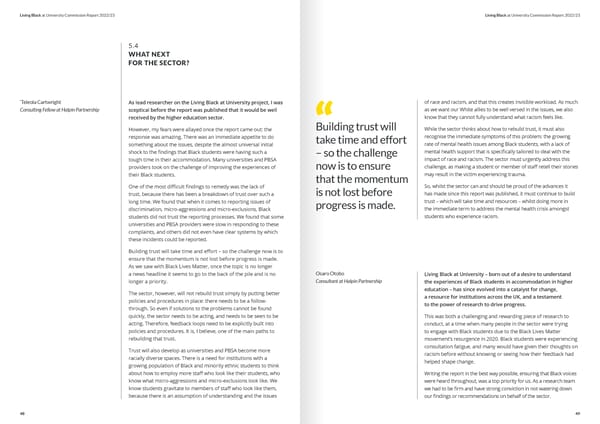Living Black at University Commission Report 2022/23 Living Black at University Commission Report 2022/23 5.4 WHAT NEXT FOR THE SECTOR? ‘Teleola Cartwright As lead researcher on the Living Black at University project, I was of race and racism, and that this creates invisible workload. As much Consulting Fellow at Halpin Partnership sceptical before the report was published that it would be well as we want our White allies to be well versed in the issues, we also received by the higher education sector. know that they cannot fully understand what racism feels like. However, my fears were allayed once the report came out: the Building trust will While the sector thinks about how to rebuild trust, it must also “ response was amazing. There was an immediate appetite to do take time and effort recognise the immediate symptoms of this problem: the growing something about the issues, despite the almost universal initial rate of mental health issues among Black students, with a lack of mental health support that is speci昀椀cally tailored to deal with the shock to the 昀椀ndings that Black students were having such a – so the challenge tough time in their accommodation. Many universities and PBSA impact of race and racism. The sector must urgently address this providers took on the challenge of improving the experiences of now is to ensure challenge, as making a student or member of sta昀昀 retell their stories their Black students. that the momentum may result in the victim experiencing trauma. So, whilst the sector can and should be proud of the advances it One of the most di昀케cult 昀椀ndings to remedy was the lack of trust, because there has been a breakdown of trust over such a is not lost before has made since this report was published, it must continue to build long time. We found that when it comes to reporting issues of progress is made. trust – which will take time and resources – whilst doing more in discrimination, micro-aggressions and micro-exclusions, Black the immediate term to address the mental health crisis amongst students did not trust the reporting processes. We found that some students who experience racism. universities and PBSA providers were slow in responding to these complaints, and others did not even have clear systems by which these incidents could be reported. Building trust will take time and e昀昀ort – so the challenge now is to ensure that the momentum is not lost before progress is made. As we saw with Black Lives Matter, once the topic is no longer a news headline it seems to go to the back of the pile and is no Osaro Otobo Living Black at University – born out of a desire to understand longer a priority. Consultant at Halpin Partnership the experiences of Black students in accommodation in higher The sector, however, will not rebuild trust simply by putting better education – has since evolved into a catalyst for change, policies and procedures in place: there needs to be a follow- a resource for institutions across the UK, and a testament through. So even if solutions to the problems cannot be found to the power of research to drive progress. quickly, the sector needs to be acting, and needs to be seen to be This was both a challenging and rewarding piece of research to acting. Therefore, feedback loops need to be explicitly built into conduct, at a time when many people in the sector were trying policies and procedures. It is, I believe, one of the main paths to to engage with Black students due to the Black Lives Matter rebuilding that trust. movement’s resurgence in 2020. Black students were experiencing Trust will also develop as universities and PBSA become more consultation fatigue, and many would have given their thoughts on racially diverse spaces. There is a need for institutions with a racism before without knowing or seeing how their feedback had growing population of Black and minority ethnic students to think helped shape change. about how to employ more sta昀昀 who look like their students, who Writing the report in the best way possible, ensuring that Black voices know what micro-aggressions and micro-exclusions look like. We were heard throughout, was a top priority for us. As a research team know students gravitate to members of sta昀昀 who look like them, we had to be 昀椀rm and have strong conviction in not watering down because there is an assumption of understanding and the issues our 昀椀ndings or recommendations on behalf of the sector. 48 49
 Living Black at University Commission Report web Page 24 Page 26
Living Black at University Commission Report web Page 24 Page 26